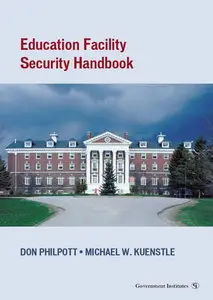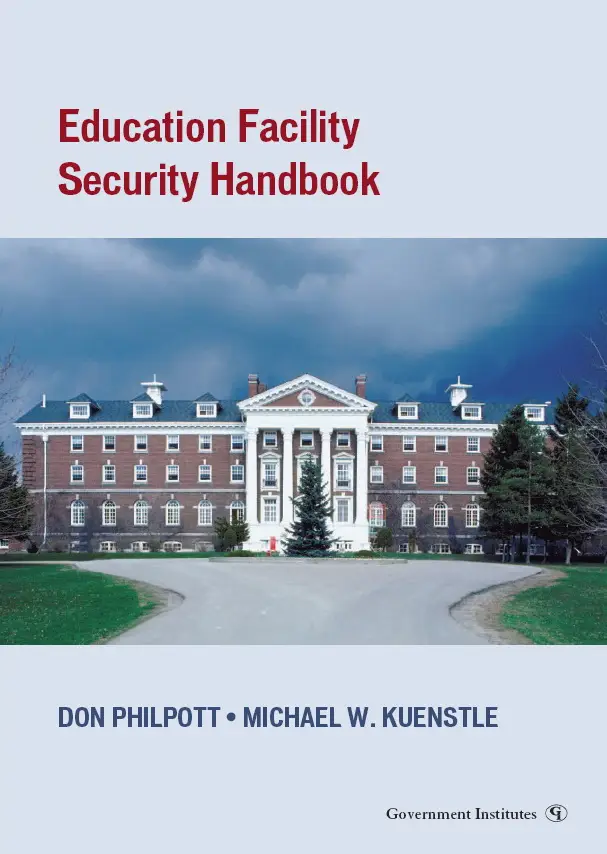Education Facility Security Handbook By Don Philpott
Publisher: Government Institutes 2007-10-28 | 464 Pages | ISBN: 0865871671 | PDF | 4.5 MB
Publisher: Government Institutes 2007-10-28 | 464 Pages | ISBN: 0865871671 | PDF | 4.5 MB
Introduction
Each weekday, about a quarter of the population of the United States attends a place of
education, either as students, teachers, or support staff. There are more than 60 million
students and teachers involved in the nation’s schools, and almost 20 million more
attend public and private universities and colleges of higher education.
Our schools and colleges are the nation’s most valuable asset—and one of the most
vulnerable. Almost every week brings new horror stories of campus shootings or other
violence.
During the past decade, more than three hundred violent deaths have occurred in
or near school campuses. The incidents don’t fit any neat patterns; they have occurred
at one-classroom rural schools, inner-city high schools, and suburban elementary
schools. Some of the more high-profile incidents in recent years include:
• An attack at a one-classroom Amish school in Pennsylvania by a thirty-two-year-old
male who shot ten girls ages six to thirteen, killing five of them, before committing
suicide.
• The Columbine High School massacre in Colorado when two male students went
on a shooting rampage, killing twelve other students and a teacher and wounding
twenty-four others, before killing themselves.
• The Red Lake High School shootings in northern Minnesota when a male student
killed his grandfather and grandfather’s parents before driving to his high school,
Our Schools and Colleges
• Approximately 55 million kindergarten to grade 12 students
• 6 million adults working as teachers or staff
• 117,000 public and private schools
• 16 million students in higher education
• 327,000 education buildings and offices in the fifty states and Washington, D.C.
where he shot more than fifteen people, including a teacher, a security officer, and five
students who all died.
While these incidents attracted enormous publicity, violence or the threat of violence,
especially gang-related, is a regular occurrence in and around many inner-city
schools, while bullying, drugs, and vandalism continue to be major concerns almost
everywhere.
Now there is the additional threat of terrorism. While no U.S. school has, to date,
suffered a terrorist attack, schools must be considered viable targets for several reasons.
Schools are a “soft and highly visible” target—accessible and easy to attack with little
protection. Imagine the fear and panic that an attack would cause, not just locally but
nationwide. An attack would certainly attract national and international media coverage,
as did the deadly attack by Chechen terrorists at a school in Beslan in southern
Russia in 2004. An attack would also almost certainly mean more police and other
security personnel being diverted to protect schools, leaving other targets vulnerable.
Even if schools are not the target of terrorism, they could be affected by an attack.
On September 11, 2001, four elementary schools and three high schools located within
six blocks of the World Trade Center were just beginning classes when the first plane hit
the north tower. Thousands of children were exposed to the dust clouds from the collapsing
buildings. Even those children not in the immediate vicinity experienced a great
deal of anxiety. Children in at least three states (New York, New Jersey, and Connecticut)
had parents working in or around the World Trade Center that day. In the Washington,
D.C., area, schools faced similar situations after the Pentagon was attacked.
Schools are an integral part of our community, and many are used for meetings
and events, as polling stations in elections, and as health care centers. In many parts of
the country that are prone to bad weather—floods, tornadoes, hurricanes, and the like—
schools are often used as emergency evacuation shelters or command centers, and in the
event of a major pandemic, such as avian flu, many would also be used as vaccination
and treatment centers.
This book is concerned with protecting our students, teachers, administrators and
other staff, and helping to keep them safe, whether it is from natural or man-made
disaster.
The handbook is divided into three parts. The first provides a basic security over -
view and discusses how to identify critical assets and then conduct risk-threat assessments.
You cannot incorporate safety and secure elements into your design until you
know what you are protecting and the threats faced.
The second part looks at planning and design considerations and best practices
that have been incorporated into new school designs. These include elements specifically
designed to protect schools and education facilities against various natural hazards—
such as earthquake, flooding, tornadoes, and hurricanes—as well as design principles
used to make schools safer and more secure.
These guidelines cover external and internal design considerations, from site selection
and parking to room layouts, protecting systems and equipment, and installing
surveillance and other controls and alarm systems. Obviously many areas are covered
by local and national building codes and these have to be complied with, but when
considering design elements to improve safety and security, layout is probably the most
critical element.
The first two parts of the book are concerned with planning, designing, and building
a safe and secure education facility. The third part is about implementing “people”
policies and practices to make our schools and colleges safer. These various practices
can help reduce drug and alcohol abuse, bullying and vandalism, as well as other violence
and crime.
This book does not claim to be an original work. Almost all the materials have
been drawn from other sources, most of them in the public domain. What this handbook
does set out to do, however, is to incorporate the best elements of design and
“people” policies from these various sources into a single publication.
In the process, we hope that we can make a modest contribution to building and
maintaining a safer and more secure environment for our nation’s students and those
who work with them.





